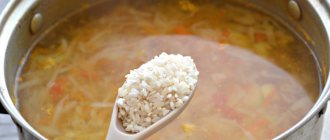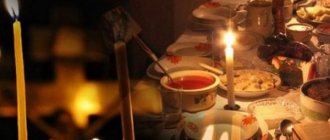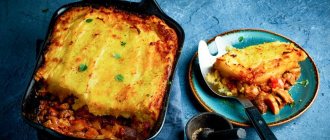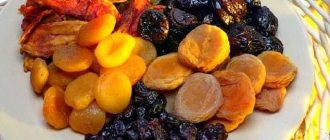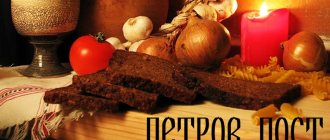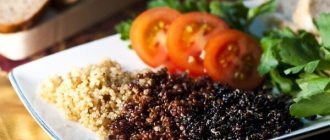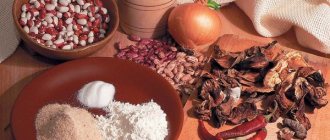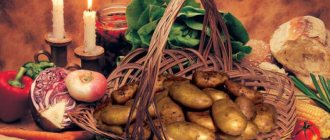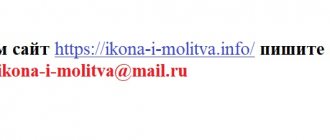The monastic kitchen is an ideal solution for those who are planning to fast. It separated into a separate branch back in the 16th century, the main emphasis was on plant foods. Meals in monasteries should consist of simple, but nutritious and healthy foods, and certainly contain the necessary vitamins. Lenten food can and should remain tasty; its preparation does not require much time and effort. Below are the best recipes for delicious monastic dishes that are easy to serve during Lent.
Recipes from monastery cuisine in Lent - the best soups step by step and with photos
For monasteries, liquid dishes are the basis of the menu. Such food helps provide the body with nutrients and required vitamins. Another advantage is easy digestibility without straining the stomach.
Monastic cabbage soup with rice
This is not just a very healthy, but also an incredibly tasty dish that is prepared in a few simple steps. With its help, you can brighten up your diet not only during fasting, but also on ordinary days.
To prepare cabbage soup we will need:
- 500 g sauerkraut;
- potatoes - 4 pcs.;
- 200 g champignons;
- carrots - 1 pc.;
- onions - 1 pc.;
- 70 g steamed rice;
- 70 g celery root;
- bell pepper - 1 pc.;
- 4 cloves of garlic;
- 3 bay leaves;
- salt, peppercorns, cilantro and dill.
Then everything is divided into simple steps:
- Place water in a 5-liter saucepan on the fire.
- Place the diced potatoes in salted water.
- We clean and cut the mushrooms, throw them into the pan.
- Chop carrots, onions, celery, peppers and garlic, sauté in oil.
- Add steamed rice to the potatoes and mushrooms and cook for 10 minutes.
- We wash the sauerkraut under water, add it to the pan along with the frying, and cook it all for another 15 minutes.
- At the very end, add bay leaf and pepper.
- Serve to the table along with greens. On the second day, cabbage soup does not lose its rich taste.
Pumpkin and Lentil Soup
A very nourishing, thick and vitamin-rich lean soup. Best served alongside green onion flatbreads, the recipe for which is included separately below.
Required ingredients for soup:
- pumpkin - 500 g;
- red lentils - 200 g;
- onion - 1 pc.;
- garlic - 2 cloves;
- vegetable oil - 2 tbsp. l.;
- lemon - 1 pc.;
- water - 1 l;
- salt - 1⁄2 tsp;
- parsley root - 100 g.
The cooking process is as simple as possible:
- We wash the lentils, place them in a saucepan, add water and after boiling, cook for 15 minutes.
- Cut the onion into feathers and sauté in oil.
- Peel the pumpkin, cut into thin slices, and fry until soft.
- Add the pumpkin directly to the lentil stew, add salt and pepper, and you can add dill seeds.
- Cook for 7-8 minutes over low heat, add lemon juice, chopped garlic and herbs.
For onion cakes we need:
- flour - 600 g;
- water - 400 ml;
- salt - 1⁄2 tsp;
- vegetable oil - 2 tsp;
- green onions - a bunch.
Next we do the following:
- Sift the flour and pour into a bowl, add half a spoon of butter and salt.
- Add warm water and knead into a soft dough, then put in the refrigerator for 20 minutes.
- Chop the green onions.
- Roll out the dough, put in the onion, roll everything into a roll, and then twist it like a snail and connect the edges, roll it all together into a flat cake.
- Fry the flatbreads in a frying pan in oil.
Borscht with mushrooms
An unusual recipe for a familiar dish, where meat is an excellent substitute for mushrooms. Apart from replacing one of the main ingredients, the recipe is not too different from the original.
For lean borscht we will need:
- 200 g of fresh mushrooms or 30 g of dried white mushrooms;
- 1-2 liters of water;
- beets - 400 g;
- potatoes - 4 pcs.;
- onion - 1 pc.;
- vegetable oil - 1 tbsp. l.;
- flour - 1 tsp;
- tomato puree - 1 tbsp. l.;
- parsley/celery root;
- greenery.
We gradually combine the components:
- Dry mushrooms are pre-soaked for a couple of hours; with fresh mushrooms we skip this step.
- Chop the roots and simmer in oil along with tomatoes and mushrooms.
- Boil the beets, grate or cut into cubes.
- Cut the potatoes into oblong pieces, boil in water until soft, add the rest of the vegetables.
- We dilute the flour in cold water, add it to the pan, and cook together for another 10 minutes.
- Toss in the greens before serving.
Breaking the fast
One day a week you can move away from the strict restrictions of your diet and “feast” - treat yourself to what you love . Save this day for going to a restaurant, a festive dinner with friends or with your family.
The beauty of the diet of the Athonite monks is that you don’t have to constantly deny yourself everything. On the contrary, you can go to visit and eat a piece of cake without a twinge of conscience, because you know: tomorrow is a fast day. Breaking the fast days helps solve the problem of feelings of deprivation and guilt typical of other diets.
Most likely, at first you will look forward to Sunday so that you can eat your fill, but gradually you will notice: you are no longer craving fatty and sweet foods, although before you could not live without them. And this is another positive property of the Athonite diet.
Pastries from the monastery - without eggs and milk
During Lent, you can pamper yourself with monastic dishes without worrying about your figure. They contain a minimum of calories, but at the same time are rich in vitamins.
Real monastery pancakes
Despite the minimum ingredients and ease of preparation, the dish turns out to be quite satisfying and tender.
You will need to take:
- flour - 1 tbsp. l.;
- water - 200 ml;
- oil - 3 tbsp. l.;
- fresh yeast - 20 g;
- sugar - 4 tbsp. l.;
- salt to taste.
Cooking does not require much effort:
- Make a yeast dough by mixing a glass of heated water, a spoonful of sugar, yeast and 3 tablespoons of flour. Leave in a warm place until a “cap” forms.
- Mix the remaining flour, salt and sugar in a bowl, slowly pour in water, oil and stir the lumps.
- Add the dough, stir the dough, cover with a lid and leave for an hour.
- Heat the frying pan, grease it with oil, and pour in the dough evenly.
- Fry on both sides.
Ring with nuts and raisins
For this dessert you will need:
- flour - 4 tbsp;
- sugar - 2 tbsp;
- raisins - 1 tbsp.;
- walnut - 1 tbsp.;
- ground cinnamon - 25 g;
- vinegar - 2 tbsp;
- soda - 2 tsp;
- oil;
- decoction with dried fruits;
- salt.
Everything is prepared in a few steps:
- Grind salt, sugar and cinnamon with butter.
- Pass the raisins and nuts through a meat grinder.
- Mix the ingredients, dilute the broth and add soda.
- Gradually pour in flour, add vinegar, mix.
- Pour the dough into a floured and oiled pan.
- Bake in the oven at 170 degrees for 1 hour.
Cake from Mother Euphrosyne
Mother from the Eleazarovsky Monastery shared her cake recipe. For it you need to take:
- sugar - 8 tbsp;
- cocoa - 2 tbsp.;
- coffee - 8 tsp;
- water - 8 tbsp.;
- flour - 12 tbsp;
- baking powder - 16 tsp;
- vegetable oil - 1.2 tsp;
- salt;
- vanillin - 2 tsp.
Cooking method:
- Mix the ingredients and pour into molds.
- Bake at 190 degrees for 30 minutes.
- Bake several cakes, grease with jam diluted with water.
History of the Trinity-Sergius Lavra
The founding date of the Trinity-Sergius Hermitage is considered to be 1337, when Bartholomew (Sergius of Radonezh) and his older brother Stefan settled on Makovets Hill near Khotkov.
First they erected a small wooden temple, and then the first monastic buildings began to appear. Gradually the first inhabitants came here, the hermitage turned into a monastery with its own way of life, around which artisans began to settle. The number of settlements grew, and in March 1782, Catherine II signed a decree on the creation of Sergievsky Posad near the walls of the Trinity-Sergius Lavra. In 1993, the architectural ensemble of the Lavra was included in the UNESCO World Heritage List, so today they are trying to relieve it as much as possible. But still, the monastery resembles a huge anthill, where all the premises are used, including those inside the stone historical monastery walls.
Bird's eye view of the Trinity Lavra of St. Sergius
Vegetable stew “Monastic”
Ingredients:
- 4 potatoes;
- 1 large carrot;
- 1 beet;
- 1 onion;
- 250 g cabbage;
- 100 g canned green peas;
- Bay leaf;
- vegetable oil;
- salt.
Finely cut all vegetables into cubes. Place them in clay pots, into which pour 100 g of hot water. Add 1 bay leaf to each pot. Close the pots tightly with lids and simmer in a preheated oven for 40 minutes. After cooking, add canned green peas, salt and vegetable oil to taste.
Photo: Depositphotos
Monks eat fish, except on days of fasting and in those cases when they themselves forbid it.
In light of the above, it is fair to ask again: do monks eat fish? Mostly yes. Although the history of Christianity also knew cases when people did not eat. For example, Saint Epiphanius reported about such monasteries. But now in the Russian Orthodox Church the ban on it, as well as eggs and milk, is valid only during Lent and other days of abstinence.
At one time, in Rus', when the charters of monasteries were formed, the emphasis was placed on the prohibition of eating meat. Fish was chosen as a replacement for him. It has continued like this ever since.
Some monks voluntarily gave up fish, although the charter does not require this.
But some prominent Christian figures also refuse fish. For example, Seraphim of Sarov preferred to eat oatmeal and chopped cabbage, but excluded all animals.
By leaving a comment, you accept the user agreement
What is cellar service?
In the 17th century, the monastery was visited by the Patriarch of Antioch, who was accompanied by Deacon Pavel of Aleppo, who recorded in detail the features of the life of all the peoples encountered on the way of the delegation. And in his book there is a separate chapter dedicated to the patriarch’s journey to the Trinity-Sergius Lavra, where it is written: “There are three great rulers in Rus' - the Tsar, the Patriarch and the Trinity Cellarer.” The Trinity cellarer was a monk who was involved in the entire monastic economy: construction, agriculture, crafts, and so on.
Now the cellar service of the monastery employs about 300 people, and one of its areas of activity is food production, catering service and the work of catering units. Every day you need to feed about one and a half thousand people - and this does not take into account pilgrims and tourists! You also need to feed guests and various delegations, including church ones.
In addition to the refectory and canteens for students, the monastery has free canteens and hotels for pilgrims who come on pilgrimage, but do not have the financial ability to pay for accommodation. Also near the walls of the Lavra there is a large complex of the Old Lavra Monastery Hotel for more comfortable accommodation. The cellar service supervises retail outlets - shops and stalls that sell monastery-produced products.
Guests of honor are treated to a small room with a fireplace located in the Red Tower above the Holy Gates
Monastery-style fish, “Festive”
Ingredients:
- pollock fillet 0.5 kg;
- 300 g mushrooms;
- 1 onion;
- 4 boiled eggs;
- 150 g sour cream;
- 100 g hard cheese;
- vegetable oil;
- salt.
Finely chop the onion and saute in vegetable oil, add chopped mushrooms to it, simmer until tender. Place the pollock fillet on a baking sheet lightly greased with vegetable oil and season with salt. Place mushrooms and onions on top of the fish, then a layer of boiled eggs, cut into slices. Grease everything with sour cream and sprinkle with grated hard cheese. Place in a preheated oven and bake until the cheese is lightly browned.
Try cooking some of these monastery recipes. After all, these dishes are simple and healthy!
Tags: Orthodox monastery, fast days, monastery cuisine
Own production
In all centuries, something was produced at the monastery: even ancient engravings have been preserved in which the Monk Sergius bakes bread, sews boots, and makes furniture. Monastic food production began in order to feed the brethren: there was a traditional monastic bakery, vegetable gardens, and a dairy farm.
At the end of 2013, self-produced products under the “Sergius Canon” brand appeared in the monastery shops. The name comes from the Greek word "canon", which translates as limit, that is, a rule that must be followed. As the cellarer of the Trinity-Sergius Lavra, Father Arkhippus, explains, the regulations are very simple: “Act according to your conscience, and treat people the way you want them to treat you. If we bake bread, then we bake it as if we wanted to bake it for ourselves, for our parents, loved ones, sisters, brothers. If we produce something, it must be natural, without substitutes for raw materials, with a preparation technology that does not spoil the product or change its properties in order to reduce the cost or speed up production. We do everything the old fashioned way, honestly. If it’s bread, then sourdough bread, if it’s cheese, then without palm oil.”
The monastery’s own products: cheeses, drinks, baked goods
First there was a cheese factory : the Italians helped set up production, and after that at least ten more monasteries came to study with them. We started making a little cheese for ourselves, and offered the surplus in stores: young cheeses, burrata, mozzarella, blue cheeses, as well as classic ones, such as Russian, and semi-hard ones.
They work mainly with Russian starters from the Uglich biofactory, and use local milk. The monastery has its own small dairy farm in the Pokrovsky monastery in the village of Saburovo, but it does not cover all needs - a minimum of five hundred liters of milk is required daily to feed the brethren and students ! Therefore, it is bought from farms in the Sergiev Posad region. During Lent, milk is used to make butter, semi-hard cheeses, and even Camembert, which has a ripening period of four weeks.
Homemade burrata
Also under the Sergius Canon brand they produce bread, confectionery, pastries, pies, frozen dumplings and hand-made dumplings, gingerbreads made according to a classic recipe without preservatives. Thanks to the natural composition, the shelf life of such gingerbread is not six months, but only twenty days. There is also a wide range of drinks of our own production: non-alcoholic kvass, lemonade, fruit juice. According to ancient recipes, not only unpasteurized monastic kvass with sourdough is prepared, but also Lenten Posad gingerbread . It is prepared without milk and eggs, but with honey and nuts.
The honey gingerbread has become a gastronomic symbol of Sergiev Posad
It’s a different story with product suppliers - not everyone can be trusted. For example, five years ago we were faced with the fact that in addition to wheat, chemical improvers were found in the flour of many flour mills. As a result, they found good flour in the Orenburg and Omsk regions, and flour with a high gluten content is supplied to the monastery from Crimea. It costs a little more, but for the monastery quality and naturalness are fundamentally important. The monastery uses about 20-30 tons of flour per month, and in the summer - up to 50 tons .
And the Lavra does not have its own fish farms: trout is brought from Onega, pike perch, pike, and cod are purchased from suppliers. In a small culinary workshop, fish are smoked mainly for their own needs, and if there is a surplus, they are offered in the monastery shops and in the Guest House restaurant.
Monks are not vegetarians
One could call the monks vegetarians, but this is not an entirely correct definition. Vegetarianism is the name given to an approach to nutrition. Monasticism is an approach to life.
The monk does not seek scientific approval for his diet . For example, there will always be people who want to argue with a vegetarian, saying that a person is a carnivore, and it is impossible to live without meat. The experience of elders, saints, monks (from any tradition, not just ours) proves that life without eating the flesh is possible.
But they don't need to get into discussions about nutrition. This is not a matter of choice, not a question of belonging to predators and herbivores. A monk may even believe that he is a predator by nature, or read about scientific research that proves the opposite. This will not affect his eating habits in any way.
The monk does not try to compensate for missing nutrients . Many famous athletes who live on a plant-based diet (for example, Mike Tyson) also manage to become record holders, but they are a different story.
They are concerned about issues of balanced nutrition and amino acid replacement. Monks are not involved in gastronomic calculations of the amount of protein and are not concerned with the issue of healthy food. They don't care about this. They simply refused to eat animals, that's all.
Nuns make seams (Spaso-Preobrazhensky Cheboksary Convent)
